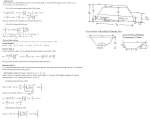Culverts.xls

Description
Calculates Pipe sizes given channel inlets and outlets and flow to be accomodated.
Culvert design is essential for managing the flow of water under roadways, railways, or embankments. The design process involves selecting the appropriate type, size, and material of the culvert, as well as considering the site's hydrology, hydraulics, and environmental factors. Here's a general outline of the culvert design method:
-
Site assessment: Evaluate the site conditions, including the topography, soil type, drainage area, land use, and any potential environmental impacts. Determine the design flow and flood frequency for the culvert, based on local regulations and guidelines.
-
Hydrology analysis: Perform a hydrologic analysis to estimate the peak design flow rate (Q) for the culvert, considering the catchment area, runoff characteristics, and rainfall intensity. Common methods for hydrologic analysis include the Rational Method, the SCS (Soil Conservation Service) Method, and regional regression equations.
-
Culvert type selection: Choose the appropriate type of culvert for the site conditions and design requirements. Common culvert types include:
- Circular (pipe) culverts
- Box culverts (rectangular)
- Pipe arches
- Elliptical
- Arch culverts
Consider factors such as the hydraulic performance, installation requirements, available materials, cost, and environmental impacts when selecting the culvert type.
-
Hydraulic analysis: Perform a hydraulic analysis to determine the required culvert size and shape, based on the peak design flow rate (Q), allowable headwater depth, tailwater conditions, and entrance/exit losses. The analysis should also consider the flow velocity, sediment transport, and potential for debris blockage.
-
Inlet control: Flow is controlled at the entrance of the culvert by the inlet geometry, entrance loss, and flow velocity. Use the flow rate and culvert type to determine the required size and shape of the culvert inlet.
-
Outlet control: Flow is controlled by the culvert's slope, roughness, and tailwater conditions. Calculate the required size and shape of the culvert outlet, considering the flow rate, allowable headwater depth, and tailwater conditions.
-
Use hydraulic design software or charts, such as those provided by the Federal Highway Administration (FHWA) Hydraulic Design Series (HDS), to perform the hydraulic analysis and determine the required culvert dimensions.
-
Material selection: Select the appropriate culvert material based on the site conditions, design requirements, durability, and cost. Common materials for culverts include:
- Reinforced concrete
- Corrugated metal (steel or aluminum)
- High-density polyethylene (HDPE)
- Polyvinyl chloride (PVC)
-
Structural design: Design the culvert's structural components, such as the walls, floor, and headwalls, to withstand the expected loads and forces. This may include vehicular loads, soil pressure, water pressure, and hydrodynamic forces. Ensure that the design meets local codes and regulations for structural design and safety.
-
Environmental considerations: Evaluate the potential environmental impacts of the culvert design, such as impacts on fish passage, stream morphology, and water quality. Incorporate design features to minimize these impacts, such as fish ladders, energy dissipators, or natural streambed materials.
-
Construction and maintenance: Plan for the proper installation and maintenance of the culvert, ensuring that the site is prepared, erosion control measures are in place, and regular inspections are conducted to identify and address any issues.
By following these steps, you can design a culvert that effectively manages water flow under roadways or other structures, while minimizing potential environmental impacts and ensuring the safety and durability of the installation.
Calculation Preview
Full download access to any calculation is available to users with a paid or awarded subscription (XLC Pro).
Subscriptions are free to contributors to the site, alternatively they can be purchased.
Click here for information on subscriptions.



